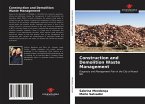In the process of consolidation and expansion of the urban area of the city of Campina Grande, which historically has been characterized by the accelerated growth of its population, and consequently, the increase of buildings and urban infrastructure works. This rapid urban territorial expansion combined with construction techniques, with a high rate of waste or loss of construction materials has generated a volume of waste that, when disposed of irregularly, generates socio-environmental impacts that burden the government. Recent studies have shown that, in medium and large urban centers, managers have been dedicating more and more attention to the effective management of the Civil Construction Waste (C&DW), which form a considerable portion of the total volume of Urban Solid Waste (USW). Thus, the civil construction industry, besides being the driving force of the Brazilian economy, is also one of the industries that generates the most waste. Seeking compliance with current legislation in Brazil.








